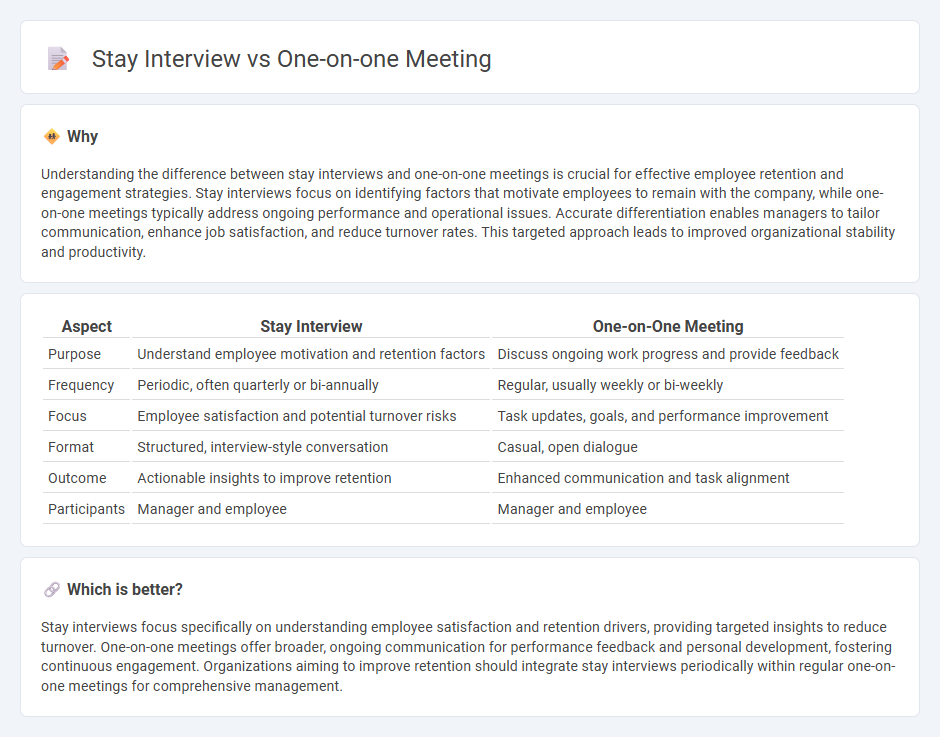
Stay interviews focus on understanding employee satisfaction and retention drivers through targeted questions, while one-on-one meetings emphasize regular communication and performance feedback between managers and team members. Both methods enhance workplace engagement but serve distinct purposes in employee development and organizational strategy. Explore how integrating both approaches can optimize management effectiveness.
Why it is important
Understanding the difference between stay interviews and one-on-one meetings is crucial for effective employee retention and engagement strategies. Stay interviews focus on identifying factors that motivate employees to remain with the company, while one-on-one meetings typically address ongoing performance and operational issues. Accurate differentiation enables managers to tailor communication, enhance job satisfaction, and reduce turnover rates. This targeted approach leads to improved organizational stability and productivity.
Comparison Table
| Aspect | Stay Interview | One-on-One Meeting |
|---|---|---|
| Purpose | Understand employee motivation and retention factors | Discuss ongoing work progress and provide feedback |
| Frequency | Periodic, often quarterly or bi-annually | Regular, usually weekly or bi-weekly |
| Focus | Employee satisfaction and potential turnover risks | Task updates, goals, and performance improvement |
| Format | Structured, interview-style conversation | Casual, open dialogue |
| Outcome | Actionable insights to improve retention | Enhanced communication and task alignment |
| Participants | Manager and employee | Manager and employee |
Which is better?
Stay interviews focus specifically on understanding employee satisfaction and retention drivers, providing targeted insights to reduce turnover. One-on-one meetings offer broader, ongoing communication for performance feedback and personal development, fostering continuous engagement. Organizations aiming to improve retention should integrate stay interviews periodically within regular one-on-one meetings for comprehensive management.
Connection
Stay interviews and one-on-one meetings are connected through their focus on employee engagement and retention by fostering open communication between managers and employees. Both tools gather valuable feedback on job satisfaction, work challenges, and career aspirations, enabling proactive management decisions. Implementing regular one-on-one meetings complements stay interviews by maintaining continuous dialogue, enhancing trust, and addressing concerns before they escalate into turnover risks.
Key Terms
**One-on-one meeting:**
One-on-one meetings are regular, structured conversations between managers and employees aimed at discussing performance, goals, and professional development. These meetings foster open communication, build trust, and address challenges proactively to enhance employee engagement and productivity. Discover how consistent one-on-one meetings can transform your workplace dynamics and elevate team success.
Feedback
One-on-one meetings center on continuous, real-time feedback between managers and employees to enhance performance and address immediate concerns. Stay interviews focus on feedback to understand employee satisfaction, motivations, and retention factors, aiming to reduce turnover. Discover more about how these feedback tools impact workplace engagement and productivity.
Development
One-on-one meetings concentrate on continuous employee development by addressing personal goals, feedback, and performance improvement in a regular, informal setting. Stay interviews focus specifically on understanding employee motivations and retention factors, aiming to identify what keeps employees engaged and what developmental opportunities could prevent turnover. Discover more about how these approaches can enhance development strategies within your organization.
Source and External Links
One on One Meetings with Employees: The Complete Guide - This guide provides best practices for effective one-on-one meetings, including setting agendas and focusing on employee well-being and development.
Manager Best Practices: One-on-One Meetings - Details the importance of regular one-on-one meetings for employee engagement and outlines a structured approach to these meetings.
The Only One On One Meeting Checklist You Will Ever Need - Offers a comprehensive checklist for preparing, structuring, and maximizing the benefits of one-on-one meetings.
 dowidth.com
dowidth.com